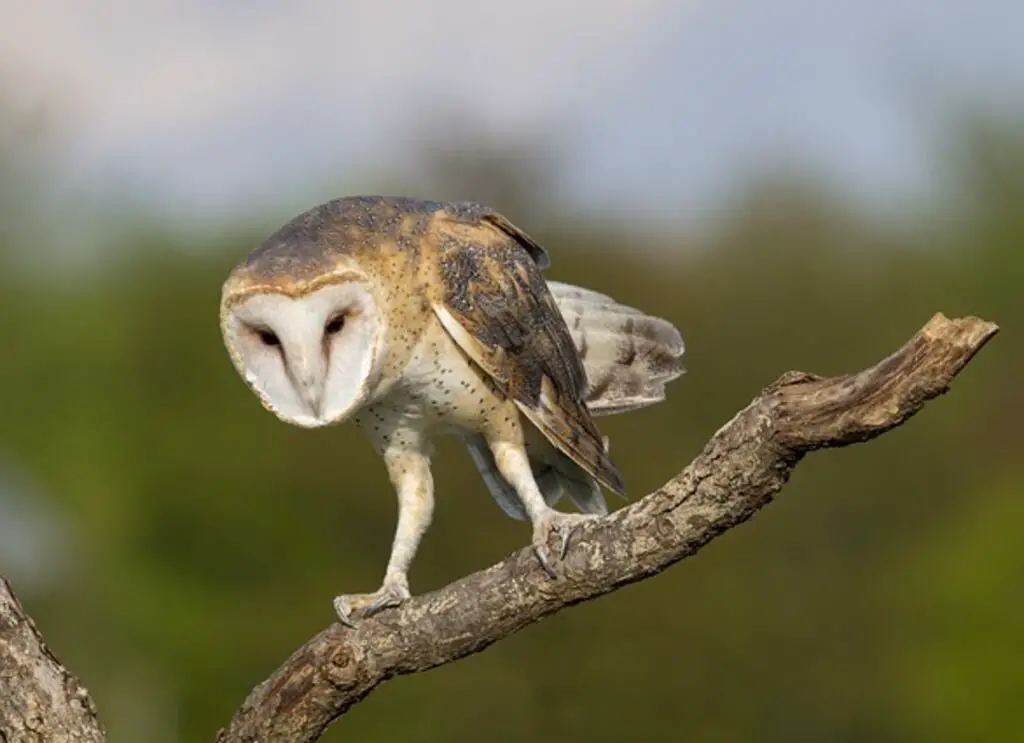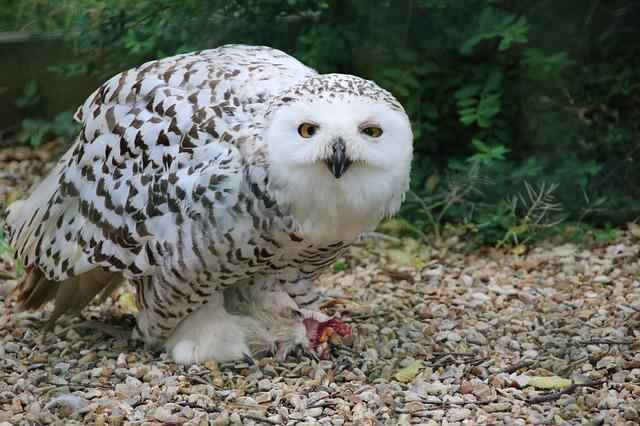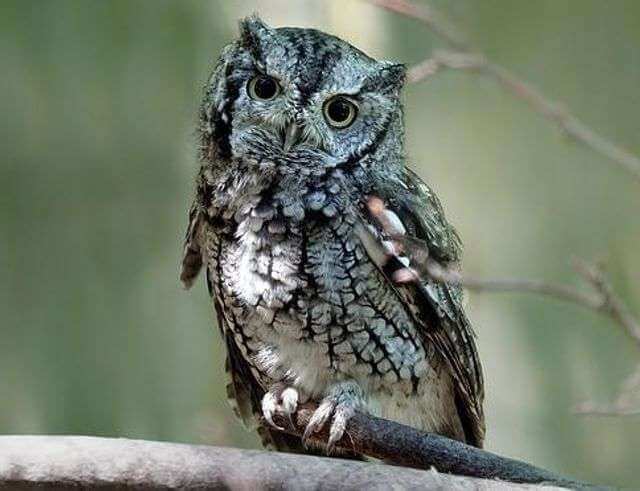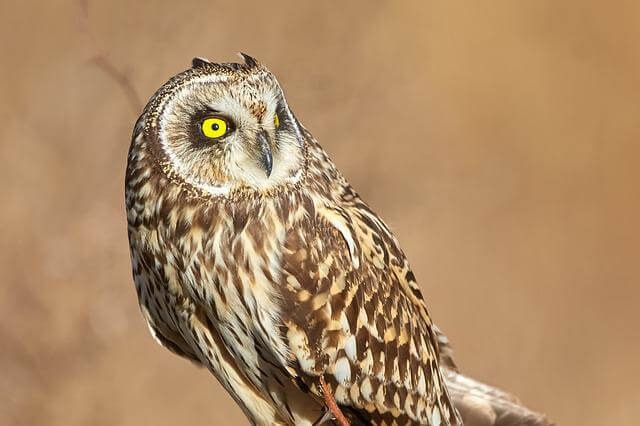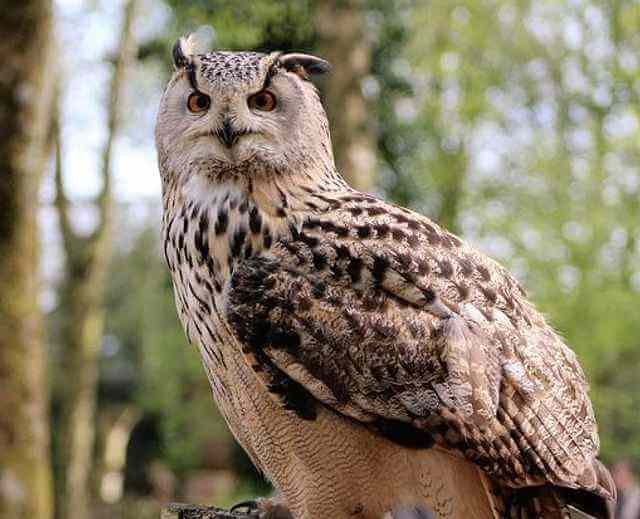Vermont’s enchanting landscapes are not only a haven for nature enthusiasts but also home to a diverse range of wildlife, including the majestic owl. With its silent flight and piercing gaze, the owl is a symbol of mystery and wisdom that captivates the imagination. In Vermont, there are 11 distinct types of owls that grace our forests, fields, and skies.
Each species has its unique characteristics, behaviors, and habitats that make them fascinating creatures to observe. Join us as we delve into the world of Vermont’s owls and discover the remarkable diversity of these nocturnal hunters that call this state home.
Table of Contents
Types of Owls In Vermont
Barred Owl
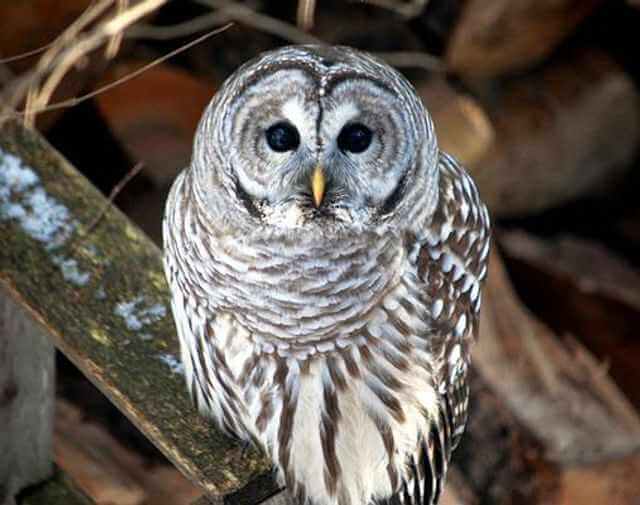
- Length: 16.9-19.7″ in (43-50 cm)
- Weight: 16.6-37.0 oz. (470-1050 g)
- Wingspan: 39.0-43.3″ in (99-110 cm)
- Scientific Name: Strix varia
- Frequency of Occurrence: 2.58% (Statistic by: eBird)
- Maps: Range Map – Sightings Map
- Sounds: Calls
- Where To Find Them: The barred owl is found in woods, swamps, and farmland in Vermont. They are quite rare, but have been spotted in the wild. Some of the places they have been seen are the Green Mountains, and the Champlain Valley.
General Information: The Barred Owl is a medium-sized owl with a large, rounded head and no ear tufts. It has dark brown eyes and a pale brownish-gray facial disc. The upperparts are brown with white bars and the underparts are pale with heavy brown streaks. The wings and tail are barred with light gray, brown, and black. The bill is yellowand the legs are feathered to the toes.
This owl ranges throughout eastern North America from southern Canada to northern Mexico. It is found in woodlands, forests, swamps, and bayous. The diet of the Barred Owl consists mostly of small mammals such as mice, voles, and shrews. It also eats birds, reptiles, amphibians, crustaceans, and insects.
Great Horned Owl

- Length: 17.7-24.8 in (45-63 cm)
- Weight: 32.1-88.2 oz. (910-2500 g)
- Wingspan: 39.8-57.1 in (101-145 cm)
- Scientific Name: Bubo virginianus
- Frequency of Occurrence: 0.4036%
- Maps: Range Map – Sightings Map
- Sounds: Calls
- Where To Find Them: In Vermont, these owls are found throughout the state in both rural and urban areas. They typically nest in trees, but can also be found nesting on cliffs or in caves. Although they are not considered rare in Vermont, Great Horned Owls are still quite elusive and seldom seen by humans.
General Information: The Great Horned Owl is a large owl native to the Americas. It is one of the most widespread owls in North America, and its range extends from Alaska and Canada to as far south as Tierra del Fuego. Great Horned Owls inhabit a wide variety of habitats, including forests, grasslands, deserts, and tundra.
They are also found in cities and towns, where they often nest on man-made structures such as buildings and bridges. Great Horned Owls are carnivores, and their diet consists primarily of small mammals such as rabbits, squirrels, mice, and voles. They will also eat reptiles, birds, amphibians, and insects. Great Horned Owls hunt primarily at night, using their keen eyesight and hearing to locate prey.
Related: 35 Fun Facts About The Great Horned Owl (Detailed)
Snowy Owl
- Length: 20.5-27.9 in (52-71 cm)
- Weight: 56.4-104.1 oz. (1600-2950 g)
- Wingspan: 49.6-57.1 in (126-145 cm)
- Scientific Name: Bubo scandiacus
- Frequency of Occurrence: 0.2941%
- Maps: Range Map – Sightings Map
- Sounds: Calls
- Where To Find Them: Snowy Owls are one of the rarest birds in Vermont. They are mostly found in the northern parts of the state, near the Canadian border. These owls are shy and stealthy, so they are rarely seen.
General Information: The Snowy Owl is a large bird of prey that can be found in the arctic regions of North America and Europe. These birds are mostly white with some dark markings on their feathers. The Snowy Owl has a round head with a stocky body and a short tail. They have large, powerful wings that help them to fly long distances. The female Snowy Owl is usually larger than the male.
Snowy Owls live in open areas where they can find lots of small animals to eat. Their diet consists mostly of lemmings, mice, and other small rodents. In the wintertime, when these animals are hard to find, the Snowy Owl will also eat birds, rabbits, and fish. It hunts throughout the night and during the day. They use their sharp eyesight and hearing to find their prey.
Related: 48 Fun Facts About Snowy Owls (Full Guide with Photos!)
Northern Saw-whet Owl
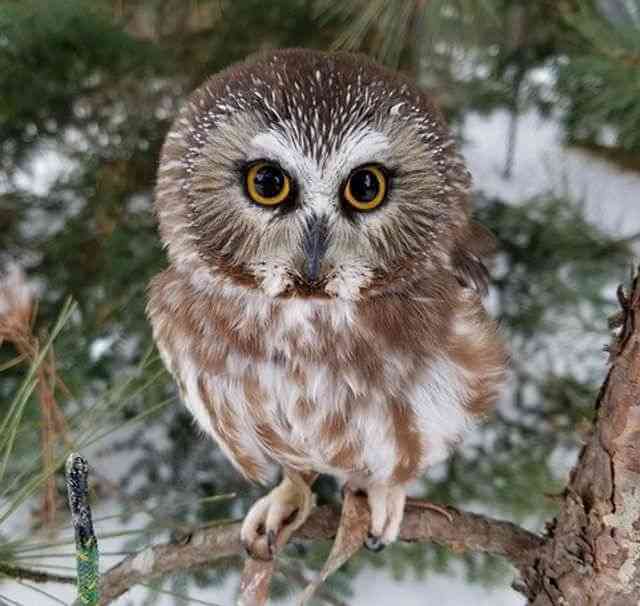
- Length: 7.1-8.3 in (18-21 cm)
- Weight: 2.3-5.3 oz. (65-151 g)
- Wingspan: 16.5-18.9 in (42-48 cm)
- Scientific Name: Aegolius acadicus
- Frequency of Occurrence: 0.1625%
- Maps: Range Map – Sightings Map
- Sounds: Calls
- Where To Find Them: In Vermont, they are found in the northern and eastern parts of the state, as well as in the Champlain Valley. They are relatively rare, but can be found in forests, swamps, and mountains.
General Information: The Northern Saw-whet Owl is a small owl found in North America. It is one of the most common owls in Canada and the northern United States. The Northern Saw-whet Owl is a bird of prey that feeds mostly on small rodents such as mice and voles. These owls hunt at night, using their sharp talons to kill their prey.
The Northern Saw-whet Owl ranges from Alaska to Newfoundland, and south to Colorado and Virginia. In the West, its range extends to central California, central Arizona, and New Mexico. In the East, it is found as far north as Maine and southern Quebec, and as far south as West Virginia. The Northern Saw-whet Owl inhabits woodlands, including both coniferous and deciduous forests.
Related: What is the Smallest Owl in North America? (A Full Guide)
Eastern Screech Owl
- Length: 6.3-9.8″ in (16-25 cm)
- Weight: 4.3-8.6 oz. (121-244 g)
- Wingspan: 18.9-24.0″ in (48-61 cm)
- Scientific Name: Megascops asio
- Frequency of Occurrence: 0.1440%
- Maps: Range Map – Sightings Map
- Sounds: Calls
- Where To Find Them: The Eastern Screech Owl is relatively rare, but can be found throughout Vermont in a variety of locations including forests, woodlands, and even near human settlements. It has two color morphs – gray and red. The gray morph is more common in Vermont.
General Information: The Eastern Screech Owl is a small owl that is found in woodlands in eastern North America. These owls are nocturnal hunters that eat small mammals and birds. The Eastern Screech Owl has two color morphs, red and gray. The red morph is more common in the southern part of the owl’s range, while the gray morph is more common in the northern part of the owl’s range.
The Eastern Screech Owl ranges from southeastern Canada to central Florida. These owls are found in a variety of habitats, including forests, woodlands, and even urban areas. The diet of the Eastern Screech Owl consists primarily of small mammals such as mice and voles. These owls will also eat birds, invertebrates, and even reptiles.
Short-eared Owl
- Length: 13.4-16.9 in (34-43 cm)
- Weight: 7.3-16.8 oz. (206-475 g)
- Wingspan: 33.5-40.5 in (85-103 cm)
- Scientific Name: Asio flammeus
- Frequency of Occurrence: 0.1254%
- Maps: Range Map – Sightings Map
- Sounds: Calls
- Where To Find Them: Short-eared owls are a fairly rare find in Vermont. However, there have been sightings in certain areas of the state. These owls are most commonly found in open fields and meadows. They have also been spotted in woodlands and near forests.
General Information: The Short-eared Owl is a medium-sized owl found throughout North and South America. It is a highly adaptable bird, able to live in a wide range of habitats from the tundra to the tropics. The Short-eared Owl is an opportunistic eater, preying on whatever small mammals or birds it can find. The Short-eared Owl has a large range, stretching from Alaska and Canada all the way down to Patagonia in South America.
This owl is found in a wide variety of habitats, including forests, grasslands, and even deserts. The Short-eared Owl is most common in open areas with some trees or shrubs for perching and hunting. This owl gets its name from its short ear tufts, which are much shorter than those of other owls.
Northern Hawk Owl
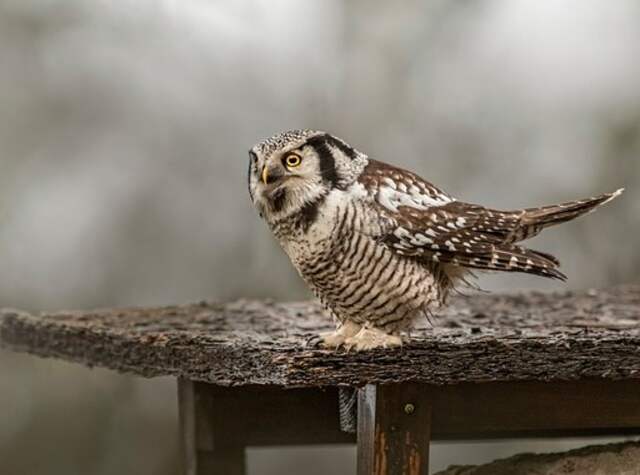
- Length: 14.2-17.7 in (36-45 cm)
- Weight: 8.5-16.0 oz. (240-454 g)
- Wingspan: 27.9 in (71 cm)
- Scientific Name: Surnia ulula
- Frequency of Occurrence: 0.0472%
- Maps: Range Map – Sightings Map
- Sounds: Calls
- Where To Find Them: In Vermont, the Northern Hawk Owl is found in the northernmost areas of the state, typically in wooded areas near forests. They are a rare owl species in Vermont, but can be seen occasionally in the wild.
General Information: The Northern Hawk Owl is a medium-sized owl that is found in northern North America, Europe, and Asia. The owl gets its name from its hawk-like appearance and hunting behavior. The Northern Hawk Owl has a round head with no ear tufts, yellow eyes, and a dark brown or gray body with white streaks on the chest and belly.
The owl typically measures 15-20 inches in length and has a wingspan of 36-44 inches. The Northern Hawk Owl is found in open forests, taiga, and tundra habitats. In North America, the owl is most commonly found in the boreal forest regions of Canada and Alaska. The Northern Hawk Owl hunts during the day and night, but it is more active during the day than most owls.
Long-eared Owl
- Length: 13.8-15.8 in (35-40 cm)
- Weight: 7.8-15.3 oz. (220-435 g)
- Wingspan: 35.4-39.4 in (90-100 cm)
- Scientific Name: Asio otus
- Frequency of Occurrence: 0.0340%
- Maps: Range Map – Sightings Map
- Sounds: Calls
- Where To Find Them: The Long-eared Owl can be found in Vermont in the northern and central parts of the state. They are most often found in forests, but can also be found in other habitats such as wetlands, farmland, and urban areas. These owls are relatively rare, but their numbers have been increasing in recent years.
General Information: The Long-eared Owl is a medium to large owl with ear tufts. Its eyes are yellow and it has a black beak. The body is brown and mottled with white. The wings are long and rounded. The tail is short and square. The legs are long and feathered. This owl inhabits woodlands, forests, and grasslands in North America, Europe, Asia, and northern Africa.
It nests in trees or on cliffs, laying 2-6 eggs per clutch. The diet of the Long-eared Owl consists of small mammals such as voles, mice, shrews, and lemmings. It also eats birds, reptiles, amphibians, insects, and earthworms.
Great Gray Owl
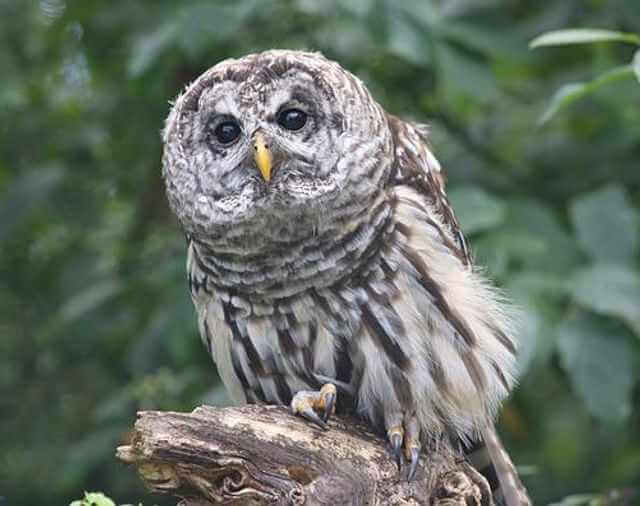
- Length: 24.0-33.0 in (61-84 cm)
- Weight: 24.7-60.0 oz. (700-1700 g)
- Wingspan: 53.9-60.2 in (137-153 cm)
- Scientific Name: Strix nebulosa
- Frequency of Occurrence: 0.0010%
- Maps: Range Map – Sightings Map
- Sounds: Calls
- Where To Find Them: These owls are found in northern forests across North America, including Vermont. Great Gray Owls are rare, and there are only a few hundred left in the wild in Vermont. These owls rely on old-growth forests for their habitat, and are threatened by logging and development. If you’re lucky enough to see a Great Gray Owl in Vermont, you’ll be sure to never forget it.
General Information: The great gray owl is a large owl of the typical owl family. They are distributed throughout the Northern Hemisphere in boreal forests. Their range includes Alaska, Canada and the northern United States. Great gray owls are one of the largest owls in North America, with a wingspan of up to 60 inches. Generally, they have round heads with yellow eyes, and the tufts of their ears are not obvious.
Their bodies are heavily feathered, and their plumage is mostly gray with some brownish bars. Great gray owls prey on small mammals such as mice, voles and lemmings. They will also consume birds, animals, and insects. Great gray owls hunt from perches or while flying low over the ground. They use their razor sharp talons to subdue their prey. Great gray owls typically nest in trees, often near water.
Related: 53 Fun Facts About The Great Gray Owl (Photos, ID & Info)
Barn Owl
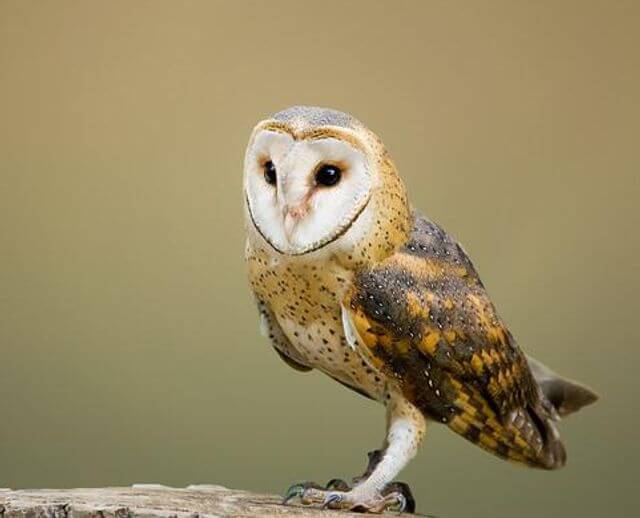
- Length: 12.6-15.8″ in (32-40 cm)
- Weight: 14.1-24.7 oz. (400-700 g)
- Wingspan: 39.4-49.2″ in (100-125 cm)
- Scientific Name: Tyto alba
- Frequency of Occurrence: 0.0006%
- Maps: Range Map – Sightings Map
- Sounds: Calls
- Where To Find Them: The barn owl is a common sight in Vermont. They can be found in most areas of the state, but are particularly common in the Champlain Valley and the Green Mountains. Barn owls are relatively rare birds, and their numbers are declining. However, they are still fairly common in Vermont, and can be seen in many different habitats.
General Information: The barn owl is a bird that can be found in many different parts of the world. They are most commonly found in Europe, Asia, and Africa. However, they have also been known to inhabit parts of North and South America as well. The barn owl is a nocturnal creature that typically sleeps during the day and is active at night.
These birds are known for their hunting skills and their ability to find prey in the dark. The diet of a barn owl consists primarily of small mammals such as rodents and shrews. They will also eat birds, reptiles, amphibians, and insects on occasion. The barn owl has excellent eyesight and hearing which helps them to locate their prey.
Boreal Owl
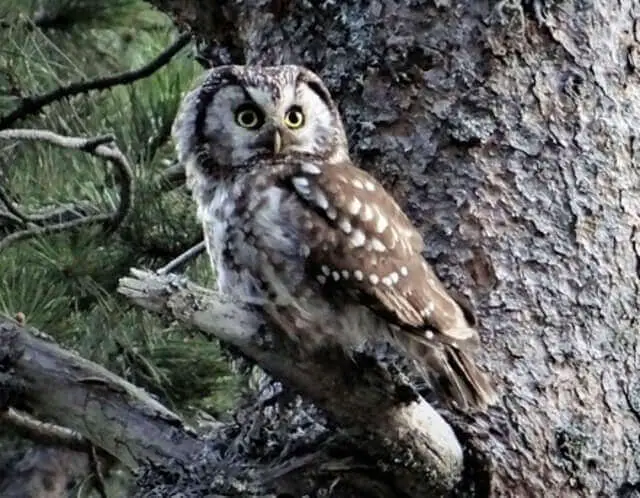
- Length: 8.3-11.0 in (21-28 cm)
- Weight: 3.3-7.6 oz (93-215 g)
- Wingspan: 21.6-24.4 in (55-62 cm)
- Scientific Name: Aegolius funereus
- Frequency of Occurrence: 0.0001%
- Maps: Range Map – Sightings Map
- Sounds: Calls
- Where To Find Them: In Vermont, the Boreal Owl is most commonly found in the Northeast Kingdom and along the Green Mountains. They are a very rare sight, so if you’re lucky enough to see one, be sure to take a picture!
General Information: The Boreal Owl is a medium-sized owl with a round head and no ear tufts. It has large, black eyes, and a beak that is yellow. The upper parts are brown with spots of white, and the under parts are white with brown streaks throughout. The Boreal Owl occurs in boreal forests of North America and Eurasia. It can be found in Alaska, Canada, and the northern United States in North America.
In Eurasia, its range extends from Norway to Siberia. This owl prefers coniferous or mixed forests with dense understories of shrubs. It nests in tree cavities or nest boxes and hunts from perches for small mammals such as voles, lemmings, and mice.
Related Post: 17 Fun Facts About Owls in 2022: That Might Surprise You!

